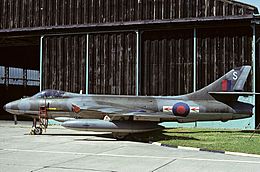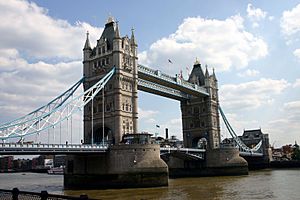Hawker Hunter Tower Bridge incident facts for kids

Hawker Hunter of the type used. Flight Lieutenant Alan Pollock was the first person to fly a jet aircraft under the upper span of Tower Bridge.
|
|
| summary | |
|---|---|
| Date | 5 April 1968 |
| Summary | Aircraft flew under bridge following unofficial flypast |
| Place | Tower Bridge, London, England, UK 51°30′20″N 0°04′32″W / 51.50556°N 0.07556°W |
| Crew | 1 |
| Injuries (non-fatal) | 0 |
| Fatalities | 0 |
| Survivors | 1 |
| Aircraft type | Hawker Hunter FGA.9 |
| Airline/user | 1 Squadron, Royal Air Force |
| Registration | XF442 |
| Flew from | RAF Tangmere, West Sussex, England, UK |
| Flying to | RAF West Raynham, Norfolk, England, UK |
The Hawker Hunter Tower Bridge incident happened on April 5, 1968. A pilot from the Royal Air Force (RAF), named Alan Pollock, did something very unusual. He flew his Hawker Hunter jet plane very low over famous places in London. Then, he flew right through the middle of Tower Bridge over the River Thames! He did this to celebrate the RAF's 50th birthday. He also wanted to show his feelings about the Ministry of Defence (the government department in charge of the military) because he felt they weren't giving the RAF enough respect.
After he landed, Alan Pollock was arrested. Later, he had to leave the RAF because of medical reasons. This meant he didn't have to go to a special military trial called a court martial.
Contents
Why the Pilot Flew Under the Bridge
In the 1960s, the Ministry of Defence started to focus more on guided missiles instead of planes with pilots. This made many people in the Royal Air Force (RAF) feel sad and worried about their future. Their spirits were low.
Flight Lieutenant Alan Pollock was a leader in No. 1 (Fighter) Squadron RAF. He was especially upset because there were no big air shows planned to celebrate the RAF's 50th birthday. The RAF was founded on April 1, 1918, so its 50th anniversary was a very important date.
On April 1, 1968, Pollock and other pilots from his squadron dropped special leaflets at other RAF bases to mark the anniversary. A few days later, on April 4, they visited RAF Tangmere in West Sussex, an air base that was soon going to close. They put on an air display there.
The Famous Flight Incident
On April 5, 1968, Alan Pollock decided to celebrate the RAF's anniversary in his own way. He planned an air display that was not approved by anyone. His flight group left RAF Tangmere to fly back to RAF West Raynham in Norfolk. Their route took them right over London.
Soon after taking off, Pollock left his flight group. He flew his Hawker Hunter FGA.9 jet, which was a single-seater plane used for ground attacks, very low over London. He flew around the Houses of Parliament three times. He did this to protest against the government of Prime Minister Harold Wilson. The government had cut funding for defence, which affected the RAF.
Pollock then dipped his wings over the Royal Air Force Memorial by the Victoria Embankment. Finally, he did something no jet pilot had done before: he flew his plane right under the top part of Tower Bridge.
Pollock knew he would likely lose his flying job because of this unauthorized display. So, on his way back to his base at RAF West Raynham, he flew upside down (an inverted flight) at about 60 meters (200 feet) over several other airfields. When he landed at RAF West Raynham, he was arrested right away.
What Happened Next
After the incident, Alan Pollock's squadron was sent to North Africa, but he stayed behind. He was later told he had to leave the RAF for medical reasons. This decision meant he did not have to go to a court martial. A court martial is a special military trial. By avoiding this trial, the government also avoided the embarrassment of Pollock explaining his reasons publicly. He might have even gained public support.
The RAF kept Pollock for two days for a medical evaluation. Many people showed support for him. For example, a company called British Overseas Airways Corporation (BOAC) sent him a keg of beer. Also, six members of the House of Commons (part of the British Parliament) spoke up for Pollock in Parliament.
Related Events
- 1974 White House helicopter incident


